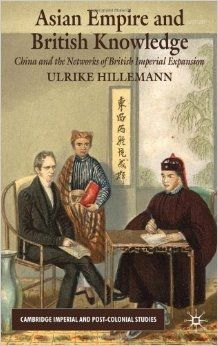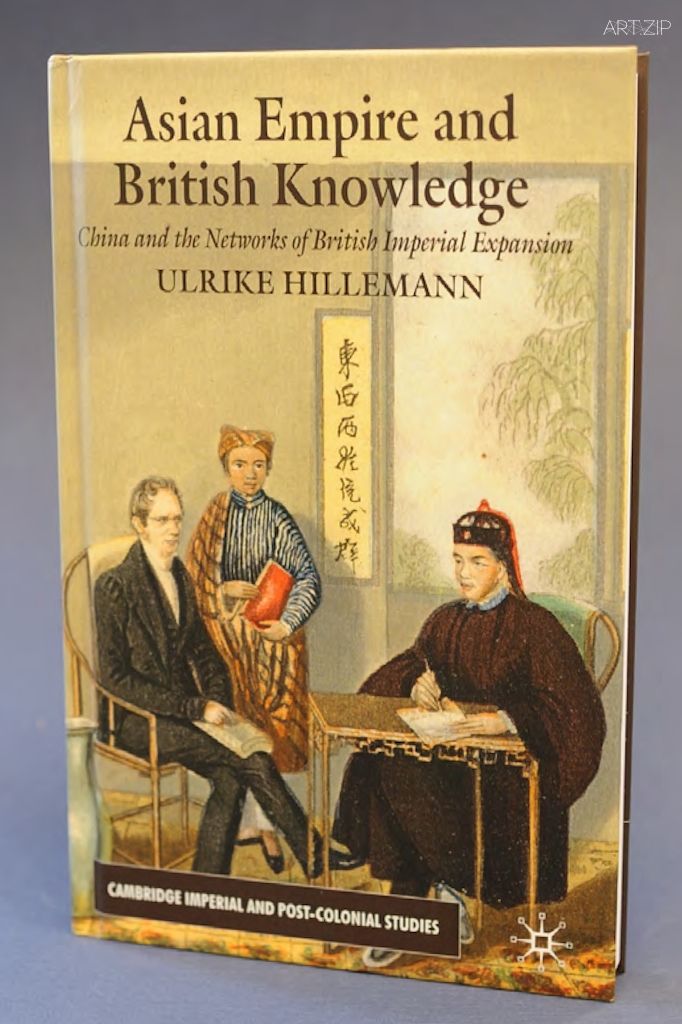
Asian Empire and British Knowledge: China and the Networks of British Imperial Expansion
《亞洲帝國與英國知識:中國與英國帝國擴張的網絡》
Beyond Colonialism—Revising the British Chinese Diplomacy during the Expansion from the Networks of Knowledge
殖民之外——從知識網絡重新檢視英國帝國擴張時期的中國方略
TEXT BY 撰文 x Jay, Chun-Chieh Lai 賴駿杰
As previously mentioned the inter-exchanges between China and United Kingdom, or the ‘contacts’, majority of people would never ignore the facts that Britain and its opponents from Europe invaded as well as occupied the Asian area. However, behind these visible conflicts among the empires, still more meanings are worth looking at and exploring actively through the micro-scope, that is, the formation and exchange of knowledge—and, following this, the cultural identity. The author, Ulrike Hillemann, allocates her sights upon the so-called ‘contact zones’, and discusses their importance for the British Asian knowledge system, and how the Chinese diverse imaginations have been formed through the episodic networking during the Imperial expansion. The ‘imagination’ also determined the way of knowing others, while the more important thing for Britain was how to achieve the ‘legitimacy’ of cultural governance by the ‘knowledge’. In the sense of the historical context, she first and foremost designated the axis and boundaries of the discussions: that/the Christianity commissions to Beijing, and almost at the same time the commercial trades with China. The reports about China sent back to Britain from the commissions and the local networking formed within the economical area—the Guangzhou, thus become the points for consideration in this book.
The author, based on the ‘network theory’ by Bruno Latour, believes that in order to understand a society, it is essential to look at the inter-relations by different sections as important in the formation of discourses. The society, for Latour, is not a given entity, but “formed through connections, and constantly transformed in the process by the actors”. As a result, in this research, Hillemann ceaselessly zoomed the scope into the so-called actors’ psychological changes. In the context, Guangzhou served as an exemplified area in which East India Company (EIC) played a key role. She took the notions of ‘periphery’ and ‘metropolis’ to examine the relationships among colonialists and their colonies, by which the identities constantly move between the peripheries and the centres, as she claimed. For instance, the interests about Chinese knowledge should not have been seen purely as how the metropolis (the UK) perceive or understand directly, but also coming from the knowledge learned from the others. Through the adjustments and modifications, it did not only attempt to alter the subjectivities of people in the colonies, but also reversely formed the Britons’ own cultural identities.
 India played an important-cum-mediate role between China and Britain. Therefore, the British government believed that because India is beside the China as one of the ‘East’ countries, the Indian experiences must have something meaningful for the governance of China. The economic concern is another important reason: the unbalance of supplement and need for ‘tea’ was the first reason for causing the conflicts. Interestingly, Hillemann adopted Arjun Appadurai’s ‘social life’ to see the goods exported from China to Britain as a sort of ‘contact zone’, through which Chinese style encountered the Britons—the Chinoiserie. This cultural alien, to some extent, became imposed as a way of disobeying the main stream, that is to say, it was being taken by rococo against the classicism and baroque taste; on the other hand, the Chinoiserie also threatened the metropolis’ local sense and made it altered, again.
George Henry Mason’s The Costume of China(1804)showed the cultural impacts generated within the (things’) contact zones, as one of the examples. Even this book, and accompanying paintings, was printed and published in China, by Chinese craft men. The work was about the factories and the cultural life around them in Guangzhou, it still carried clear exoticism and bias. The book used Chinese watercolour, not Chinese ink, a form which was being exported to Europe since the mid 18th century. This style corresponded to the stereotype of China. What the British needed was what they imagined as the ‘other’. On the other hand, the Chinese ink painting and how they engaged with ‘landscapes’ also stimulated Britain, and therefore Britons developed their specific ‘genre paintings’. The Chinese Exhibition happened in April and May 1827 could be seen as a prototype of new knowledge-based economy that were formulated and driven by curiosity about the unknown others during this period. It thus activated more investigations and more needs of other cultures.
India played an important-cum-mediate role between China and Britain. Therefore, the British government believed that because India is beside the China as one of the ‘East’ countries, the Indian experiences must have something meaningful for the governance of China. The economic concern is another important reason: the unbalance of supplement and need for ‘tea’ was the first reason for causing the conflicts. Interestingly, Hillemann adopted Arjun Appadurai’s ‘social life’ to see the goods exported from China to Britain as a sort of ‘contact zone’, through which Chinese style encountered the Britons—the Chinoiserie. This cultural alien, to some extent, became imposed as a way of disobeying the main stream, that is to say, it was being taken by rococo against the classicism and baroque taste; on the other hand, the Chinoiserie also threatened the metropolis’ local sense and made it altered, again.
George Henry Mason’s The Costume of China(1804)showed the cultural impacts generated within the (things’) contact zones, as one of the examples. Even this book, and accompanying paintings, was printed and published in China, by Chinese craft men. The work was about the factories and the cultural life around them in Guangzhou, it still carried clear exoticism and bias. The book used Chinese watercolour, not Chinese ink, a form which was being exported to Europe since the mid 18th century. This style corresponded to the stereotype of China. What the British needed was what they imagined as the ‘other’. On the other hand, the Chinese ink painting and how they engaged with ‘landscapes’ also stimulated Britain, and therefore Britons developed their specific ‘genre paintings’. The Chinese Exhibition happened in April and May 1827 could be seen as a prototype of new knowledge-based economy that were formulated and driven by curiosity about the unknown others during this period. It thus activated more investigations and more needs of other cultures.
The period from 1760s to 1940s was the cruel one for the formation of Chinese impression in the eyes of Britons. Before the commercial trades conducted by EIC, they sent ambassadors. Those early ambassadors were convinced that it makes it easier to communicate with the local communities by understanding the local customs, clothes, laws and languages. The ‘Chinese experts’ believed the Chinese knowledge not only could help them know more about their cultures and people, but, more importantly, enabled them to raise the flag of ‘progressive’ in the final stage. Since the Enlightenment between 17th and 18th centuries, European countries deeply believed that the so-called ‘cultural progress’, and the ‘knowledge’ was what they depended on. It means that they had the responsibilities to salvage those deemed ‘savage and uncivilised’, and to govern and educate them. The belief of knowledge indeed brought them speedy technological developments, while it also motivated the Imperialism. The British ambassadors’ ideas of enlightenment, such as Henry Dundas were mixed into the ‘colonial diplomacy’ at the time.
The author stepped closer to the British community formed in Guangzhou in the early 19th century and before. The fact is that at the time Britain had no military threat to Guangzhou, and the duration they stayed and their ways of connection were under severe surveillance by China. There were even fewer conversations, the passenger-like British communities still saw Chinese Empire as a negative ‘Other’. The misunderstandings thus caused recurring conflicts. Especially, after 1815, when Britain basically failed its expansions, China became more important in the sense of resources and economics. However, the Chinese experts knew little about the local cultural context, not to mention the conversations with local intellectuals before the Opium Wars (1840-42). According to Hillemann’s research, the reason is due to the language, which they faced as a problem first. Besides, the linguistic research about Chinese, which always came with the certain objectivity—translations of Bible as a means of salvage and the methods of governance. Due to this, the British government decided to commission a new ambassador and tried to find out the exact reason. ‘Translator’ would be the key. John Barrow, as one of the early ambassadors, authorised officially with Chinese learning, emphasised in a letter to the government that, the translators upon whom Britain relied in the past did not truly convey what the Chinese people meant. The reason was that earlier than the officially organised ambassadors, most tasks of translations had have been taken by the Catholic missionaries. The problem was that they “did not want or dare to really help the ‘Heretics’”.
To conclude, the book deliberately considers the past results of related research from the different aspects, and it offers, based upon the network theory, readers a distinct but micro-scopic look at this historical period. Thus, it enforces us to take the humanity into account when talking about the histories during the so-called military colonialism. The British-Indian knowledge also helped this ancient empire accommodate the myth of ‘Orientalism’, and then construct their specific genealogy of Chinese studies. The understandings and imaginations about China as the other that responded to itself and formed the British self-image from the different contexts. In addition to the rebellion against the main stream by using the Chinoiserie, another significant impact was their national confidence. Namely the British culture hegemony: they were authorised to enlighten and help the China, an old country with moral minorities (at the time, Britain thought China as a strong adversary but with weakness of morals).
In the practical sense, these Britons who had Chinese experiences and returned to the UK not only formed the Chinese knowledge in Britain, but afterwards became the fundament for further expansion into the Asia. While, the Chinese form of government was contradictory to the European ones, and its special traditional intellectual networking was not, perhaps the linguistic limitation discussed, as expected in the book. Under this context, the Chinese resistance against the ‘equality’ as well as the ‘open’ (physically and theoretically), and how it took a distinct road from the West and other Asian areas and afterwards created the ‘New China’ was absent in the book.
提到中英文化交流,或者我們說“接觸”,多數人總是無法忽略英國於殖民擴張時期,與其歐陸同盟——同時也是其對手——共同侵略且瓜分亞洲各地的事實。然而,在這些帝國對帝國之間的衝突背後,還有更多值得以微觀的角度檢視與探討的積極意義,即知識的形塑與交換,與隨之而來的文化認同。作者烏爾里克·希里曼(Ulrike Hillemann)將重點擺放在她稱之為“接觸區(contact zones)”的地方,討論其在英國於亞洲知識系統的重要性,以及帝國擴張的階段性網絡中所形塑而成之(英國對於)中國的多元想像。而所謂的想像,也自然決定了認識他者的方式,然而,對英國來說更重要的是如何透過這些“知識(knowledge)”,進而尋求文化治理的“合理性(legitimacy)”。就歷史脈絡而言,作者首先劃定了其討論的軸線與範疇,即基督傳教士至北京,以及幾乎同時啟動的與中國之貨貿往來。傳教團所送回英國的中國報告,以及在特定貨貿區域(廣州)所形成的小型知識網絡,與英人與華人社群之交流(包括英國本土)等,遂成為本書考量的重點。
作者以布魯諾·拉圖爾(Bruno Latour)的“網絡理論(network theory)”為主要論述框架,拉圖爾認為,對於一社會結構的了解,應該同時且對等地看待其中構連的過程,以及其所形塑而成的各個群體。所謂的社會,對拉圖爾而言,並非是“給定的(given)”實體,而是“在過程中透過連結,以及行動者所不斷形成的”。因此,在研究中作者持續地拉近視角,甚至觸及到所謂行動者們的心理變化。在其脈絡中,廣州為主要的考察區域,而之中扮演關鍵角色的自然是東印度公司(East India Company, EIC)。作者大量地使用“邊陲(periphery)”與“宗國(metropolis)”的概念,認為所謂的殖民主與其殖民地(或者政權延伸地區)之間的關係,就是在“邊緣(periphery)”與“中心(centre)”之間不斷地主體轉換的過程。舉例而言,英國對中國的知識觸角,並不能單純地視之為宗國(英國)對其純粹的認知或概念,而也常來自英國自其帝國中他者的知識反饋,並透過往復的調節與修改,不僅有意識地企求改變被殖民地的主體認同,更因此反過來形塑出英國人自身的文化認同。
在中國與英國之間,扮演重要緩衝角色的即印度,因此相對地,東印度公司也成為其中關鍵的意義形塑網絡。英國相信,印度與中國皆處東方且比鄰而居,其印度經驗必能作為治理中國的借鏡。而另一更重要的因素,即經濟的考量:茶葉需求的供不應求(因為清朝嚴格管控茶葉的輸出),遂成為中英衝突的第一導火線。有趣的是,她用了阿爾君·阿帕杜萊(Arjun Appadurai)關於物有其“社會生命(social life)”的概念,將進口至英國的貨物亦視為一種“接觸區”,透過它們,“中國樣式(Chinese style)”也因此接觸且遭遇了“英國人(Britons)”,而生成了“英式中國風(Chinoiserie)”。此一文化的異質物,在某種程度上成為了反叛主流風格的手段,即被洛可可所採用以衝突古典與巴洛克的品味;當然,中國風也反過來威脅了英國本土文化的品味,並使之再次地變異。
喬治·亨利·梅森(George Henry Mason)的《中國服飾(The Costume of China)》也反映了(物品的)接觸區所生成的文化影響,透過中國匠人之手,以繪畫形式考察了廣州的工廠與周邊文化。即便這本書是在中國付印,但依然保有明顯的異國情調,或者偏見。例如,其所使用的水彩風格,是18世紀中葉開始大量傾銷至歐洲的外銷彩墨風格,而不是“中國水墨”。因為這是過去歐洲人帶回去的關於中國的刻板印象,他們所需要的是其想像中的“異國”。另一方面,中國水彩對自然風景的著墨與研究,也帶給英國刺激,而發展了現在所廣為人知的“類型畫風格(genre painting)”。有趣的是在1827年四、五月時的一個《中國展覽(China Exhibition)》,幾乎可以說是在這段期間中,殖民強國對於未知他者的好奇而形成的新知識經濟之原型,並因此驅動了更大規模的探詢:對於異文化的需求與販售。
1760s到1840s是中國印象在英國人眼中形成的關鍵時期。首先透過大使的派駐,爾後才是東印度公司(EIC)更具規模的商業交易。這些早期的大使們相信,了解當地的服飾、法律及語言,可以使其更輕易與在地社群溝通。他們常以“中國專家”自居,不僅相信這對於中國的知識可以幫助理解其文化與人民,對他們更重要的是,這可以讓他們得以在最終階段高舉“進步”的旗幟。誠如我們所熟知的,歐洲於17、18世紀所發生的啟蒙運動,促使歐陸諸國深信“文明的進步”,而所依靠的即是“知識”。這意味著他們有責任去解救“蠻荒與落後”,治理且教育之。對於知識的信仰,確實也帶來科技的快速發展,但也因為這背後對於“未知”的渴求,帶來了帝國主義的殖民擴張。英國大使們,如亨利·鄧達斯(Henry Dundas)等人的啟蒙思想,也因此混雜成為了英國當時的“殖民地政策”之一環。
作者將視角更為拉近,關注了早期19世紀初與之前在廣州所形成的英國社群。因為當時英國在廣州的角色並不帶有任何軍事上的威脅,對於佇留的時間以及對外的通訊方式等,中國亦加以嚴格控管。即便偶爾有對話,但如過客般的英國社群,依然視中國當權為一負面的“他者(Other)”。這樣的誤解頻生,也造成有心人士得以輕易操弄,因此導致中英之間的大小衝突不斷。特別是,1815年之後,英國對外擴張的計畫處於失利狀態,中國,在資源與經濟的考量上也就愈形重要。然而,這些居住在廣東廣州的“中國專家”們,在鴉片戰爭(1840-42)之前,對於在地文化脈絡的認識仍極其有限,而與當地知識份子的交流更是鮮少。究其原因,語言即首先面對的難題,特別是當語言的研究挾帶了特定任務性目的——作為救贖的傳教(聖經翻譯),以及文化治理的手段時。有鑑於此,英國決定派遣新的大使,並檢討過去績效不彰的原因,發現“翻譯者”可能是個重要關鍵。作為早期正式被授命且學習中文的翻譯者,約翰·巴羅(John Barrow),在提交給高層的信件中強調,英國過去所仰賴的翻譯者並沒有忠實地傳達語意,因為更早之前大部分場合皆依靠早期前往中國傳教的天主教士,但問題癥結在於,他們也往往“不願意或不敢真的去幫忙‘異教徒(Heretics)‘”。
總體言之,本書多方考慮了過去的研究成果,其根基於區域網絡理論,並以獨有的“接觸區”為方法,重新為讀者提供了有別於歷史教科書的微觀視角,在所謂武裝殖民的歷史書寫中也多了些許人文考量。而英國當時對印度的治理所帶來的比較性知識,也讓這一帝國調整了過去對於整一的“東方主義(Orientalism)”之迷思,因此建構出獨特的中國研究之系譜學。此外,對他者中國的理解與想像,也在不同脈絡中反饋且形塑了英國的“自我形像(self-image)”。除了前述所謂中國風被用以反叛主流文化之外,另一主要的影響即是民族自信,意即英國人當時咸信的文化領導權:其被賦予使命以啟蒙、解放道德低落的中國(在當時,英國認為中國為一強勢的威脅,主要的缺陷在於“道德”。就實際層面的考量,這些早期擁有中國經驗的英國人,也透過各種方式形塑了英國本土的中國知識,而這也隨後造就了英國與其他帝國強權不同的亞洲經驗與後續擴張。然而,有別於歐陸政體之中國清朝的政治體制,與傳統文人的智識交流及其結構等,或許因為語言的考量並沒有太多地在本書中被討論。在此脈絡下,中國對於“平等”或“開放”的抗拒(實際地與概念地),以及其後續如何走向一條迥異於西方各國乃至亞洲的道路,而造就了所謂“新中國”的政經變化,亦在本書中缺席。

